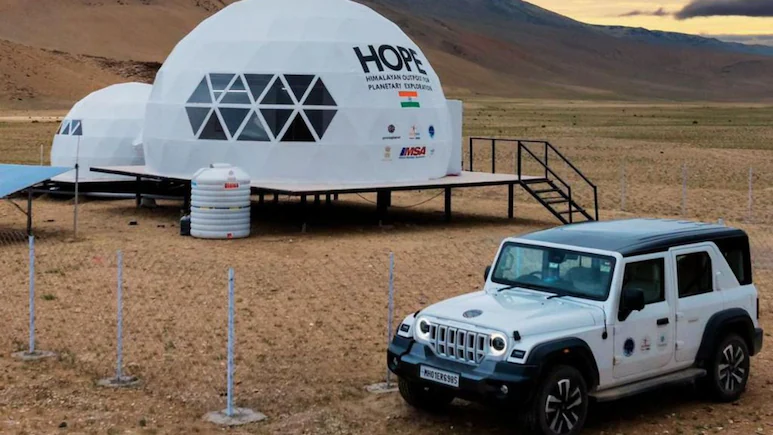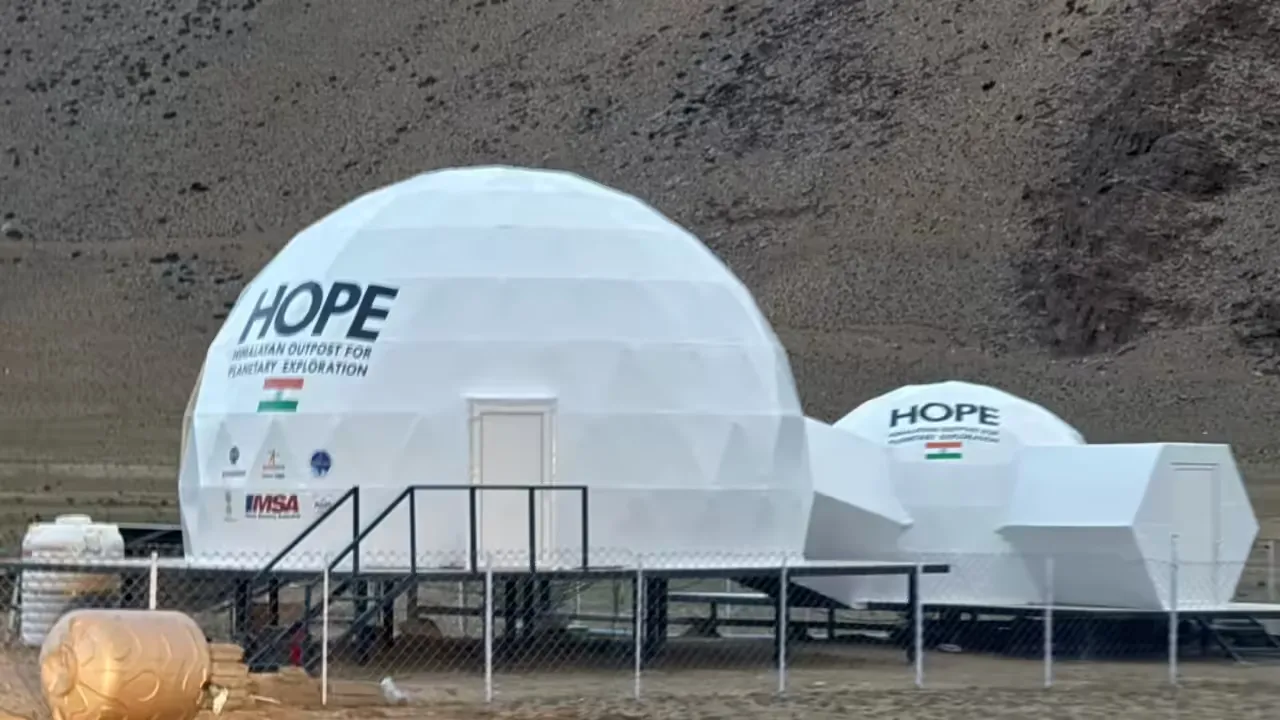India has taken an inspiring step forward in space exploration with the creation of HOPE — the Himalayan Outpost for Planetary Exploration. Nestled in the high plateaus of Ladakh, this purpose-built habitat brings many of the challenges of space closer to home so engineers, scientists and future explorers can learn, practice and innovate in a realistic, hands-on setting. HOPE is a practical, optimistic milestone: a place where technology and human ingenuity meet to prepare India for the next era of crewed space missions.
Table of contents
- A place that trains like space
- What HOPE looks like and how it works
- People first: training and human-centered research
- Technology testing that saves time and money
- Collaboration and partnership
- Local benefits and environmental care
- Inspiring the next generation
- A boost to national capability
- Global connections and soft power
- Looking forward: exciting next steps
- A source of national pride and scientific progress
- Conclusion
A place that trains like space
HOPE is located in an environment that shares key features with extraterrestrial landscapes: high altitude, clear skies, dry terrain and wide open spaces. These natural qualities make it an excellent stage for testing habitats, power systems, life-support ideas and field operations that will be essential for long-duration missions. By working in this real-world laboratory, teams gain confidence in equipment and procedures well before systems are deployed in orbit or beyond.
The lesson is simple and powerful: practice where the conditions are demanding. HOPE gives researchers the chance to trial new gear, refine human-centered designs and rehearse mission plans in a setting that prepares people and systems for the unexpected — all while remaining safe, recoverable and cost-effective.
What HOPE looks like and how it works
HOPE is designed as a compact, efficient habitat made up of living and utility modules. Inside, crews live, work and run experiments just as they would aboard a spacecraft or a planetary outpost. The habitat supports environmental controls, basic life support trials, communications testing and simulated field walks. Importantly, it also encourages teamwork, discipline and routines that mirror real missions.
These short, focused test campaigns provide a fast feedback loop: a design is trialed, data are collected, improvements are made, and the next trial begins. That iterative cycle accelerates innovation and helps build systems that are robust, user-friendly and well suited for longer missions.
People first: training and human-centered research
HOPE brings together engineers, life-science researchers and analogue crew volunteers in a shared mission: to understand how people live and perform in confined, mission-like conditions. That human-centered research is vital. It helps teams design habitats that support sleep, work schedules and social interaction. It shows how simple choices in layout, lighting and routine can enhance wellbeing and team cohesion.
Training at HOPE also builds real skills. Crew members practice real procedures — from donning suits and managing supplies to operating communications systems and troubleshooting equipment — in a setting that builds both technical competence and calm problem-solving under pressure. The outcome is a workforce and a training pipeline that are mission-ready.
Technology testing that saves time and money
Analogue habitats like HOPE provide an efficient way to test technologies before they are committed to expensive flight hardware. Systems for thermal control, portable power, water re-use and communications can be trialed, adjusted and validated on-site. This approach reduces risk, shortens development cycles and makes innovation more accessible for smaller companies and university teams.
Because HOPE supports rapid prototyping, domestic suppliers and startups can participate in meaningful ways: they can trial components, gather performance data and refine products in real conditions. That involvement builds an ecosystem of local expertise and manufacturing capability that strengthens the wider space program.
Collaboration and partnership
HOPE is a collaborative effort involving government research centers, private firms, universities and volunteer experts. That collaborative model multiplies strengths: institutional experience, engineering talent, academic research methods and entrepreneurial agility all converge in one place. International partnerships and exchanges with analogue experts elsewhere add further value, creating a global network of knowledge that India is now actively contributing to and benefiting from.

The result is a hub where ideas travel fast and good practices spread quickly across teams, institutions and borders. HOPE becomes a node in a growing community of planetary exploration practitioners.
Local benefits and environmental care
Building HOPE in Ladakh brings immediate local advantages. Field operations create jobs, develop logistics know-how in remote environments, and open opportunities for regional universities and service providers to work on cutting-edge projects. Outreach programs connected to the site inspire students and communities, creating pathways into STEM careers.
At the same time, the HOPE program emphasizes respectful stewardship of the fragile high-altitude environment. Project teams work closely with local authorities and communities to minimize footprint, restore sites after trials and invest in sustainable practices. This careful, collaborative approach creates lasting goodwill and ensures that scientific progress goes hand in hand with environmental responsibility.
Inspiring the next generation
One of HOPE’s most uplifting impacts is its power to inspire. Seeing a mission-ready habitat in the Indian highlands, hearing stories of analogue crew training together, and watching students visit nearby research activities sparks curiosity. HOPE serves as a tangible example that careers in space are within reach — for engineers, technicians, scientists and operators across India.
Educational programs tied to the project create hands-on learning, internships, and research opportunities. Schools and universities can use HOPE as a case study in everything from systems engineering and planetary science to human-centered design and sustainability. That inspiration fuels talent pipelines that will power India’s space ambitions for decades.
A boost to national capability
HOPE strengthens India’s overall readiness for human spaceflight by accelerating development in critical areas: habitability design, field operations, life-support systems and crew training. The experience gained on the plateau informs future mission planning, helps refine crew selection and training programs, and builds confidence in domestic technologies.
By investing in accessible, repeatable testing on Earth, India multiplies its ability to prepare for ambitious missions — from robust crewed flights in low Earth orbit to lunar sorties and beyond. HOPE is a practical, scalable building block on a path to greater human presence in space.
Global connections and soft power
Analogue programs are inherently collaborative, and HOPE positions India as a constructive partner in the global exploration community. Scientific exchanges, joint experiments and shared training opportunities strengthen ties with international partners while showcasing India’s technical and programmatic strengths. That kind of constructive engagement builds soft power: it demonstrates leadership, competence and a commitment to peaceful, cooperative exploration.
Looking forward: exciting next steps
HOPE’s early campaigns set the stage for more ambitious activities. Planned next steps include longer-duration trials, more varied crew compositions, new technology payloads and expanded participation from academic and industry partners. Each campaign will add layers of experience and data that feed directly into training programs and hardware development.
As HOPE evolves, it will continue to be a lively testbed for innovation — a place where ideas become tested designs, where teams learn together, and where young researchers can gain hands-on experience. That iterative, people-centered progress is exactly what drives successful, sustained exploration.
What’s Good About It
- Next-level innovation: Establishing realistic, Earth-based training environments pushes the boundaries of space exploration excellence.
- Inspiring new possibilities: HOPE opens doors for future astronauts, researchers, and dreamers—even beyond India—to engage with planetary science.
- Scientific and global prestige: This project showcases India’s growing capabilities and leadership in space research and mission readiness.
3. Why This Brings Positivity
This achievement is both a testament to human courage and a reminder that when we pursue curiosity and exploration, we tap into our shared potential. HOPE symbolizes a future where earthbound dreams reach for the stars, uniting people across generations and continents through a vision of discovery and wonder.
A source of national pride and scientific progress
HOPE is more than a test habitat: it is a symbol of India’s forward-looking approach to space exploration. It shows how careful planning, cross-sector partnership and a focus on people can create practical platforms for big ambitions. HOPE’s success reflects the combined talents of scientists, engineers, students and local communities — together creating a foundation for future achievements.
Conclusion
India’s “Mars on Earth” is a positive, practical and inspiring step toward human space exploration. HOPE brings together technology, training and teamwork in a real-world laboratory that accelerates learning and strengthens national and international collaboration. It creates opportunities for innovation, education and local development while building the experience needed for future missions.
HOPE’s presence in Ladakh is a reminder that exploration advances through steady, shared effort — and that by practicing here on Earth, we prepare better for journeys beyond it. If you’re curious, excited or motivated by space, HOPE is a story to follow: it shows how vision, teamwork and real-world testing can turn aspiration into achievement.
We’d love to stay connected.
Tap to join our WhatsApp channel and receive thoughtful updates, friendly advice, and helpful reminders direct to your phone.
